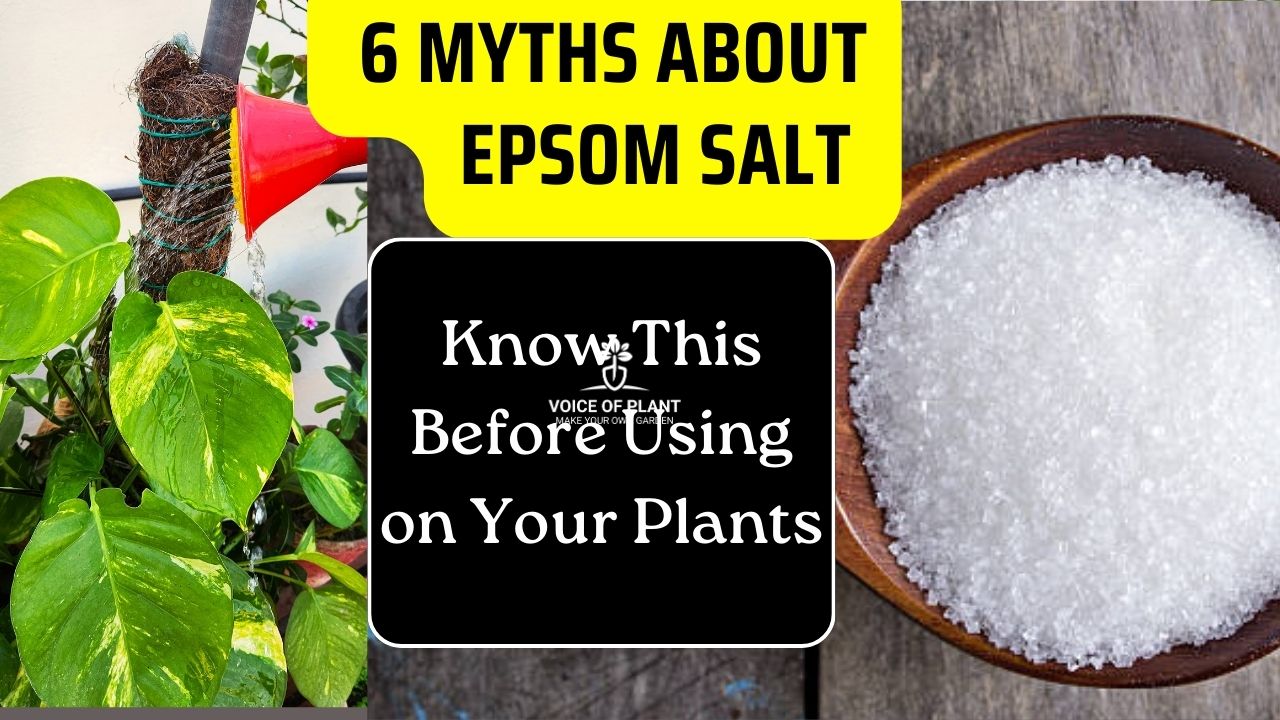Myths About Epsom Salt in Gardening
Epsom salt has gained popularity among gardeners for its supposed miraculous benefits. Many people believe it can cure all plant problems, from poor growth to pest infestations. But how much of this is actually true? Let’s bust some common myths about using Epsom salt in gardening and separate fact from fiction.
6 Myths About Epsom Salt in Gardening You Must Know
Myth 1: Epsom salt is Eating Salt – Sendha Namak
Many people confuse Epsom salt with table salt (sodium chloride) or rock salt (Sendha Namak). However, Epsom salt is chemically different.
It consists of magnesium sulfate, a completely different compound that does not have the same effects as sodium-based salts.
Epsom salt vs. table salt:
While table salt contains sodium, which can harm plants by causing dehydration, Epsom salt contains magnesium and sulfur, which play roles in plant growth but are not always needed.
Misconception:
Some people think that since Epsom salt has “salt” in its name, it works similarly to other salts. But Epsom salt is not a seasoning or a food ingredient—it’s a mineral compound with specific uses.
Myth 2: Can Be Given Directly to the Soil
Many gardeners believe that simply sprinkling Epsom salt on the soil will benefit plants, but this is not entirely true.
Fact:
Plants do need magnesium and sulfur, but they rarely suffer from deficiencies unless the soil is already depleted.
- Blindly adding Epsom salt without testing the soil can cause an imbalance.
Possible harm:
Excess magnesium can interfere with calcium absorption, leading to weaker plants.
- It can also leach into the water supply and harm the environment.
Proper usage:
If a plant shows magnesium deficiency (yellowing between leaf veins), a soil test should confirm the need before applying diluted Epsom salt as a foliar spray or soil amendment.
Myth 3: Epsom Salt is a Miracle Fertilizer for All Plants
A widespread myth is that Epsom salt acts as an all-purpose fertilizer. While it does provide magnesium and sulfur, these are only two nutrients out of the many essential for plant growth.
Fertilizers vs. Epsom salt:
A complete fertilizer contains nitrogen, phosphorus, and potassium (NPK), which are critical for plant development. Epsom salt lacks these vital nutrients.
Magnesium deficiency:
Some plants, like tomatoes, peppers, and roses, may benefit from extra magnesium in poor soil, but most plants already get enough from natural compost and organic fertilizers.
Overuse consequences:
Applying Epsom salt when it’s not needed can disrupt soil nutrient balance and contribute to poor plant health rather than improvement.
Myth 4: Epsom Salt Controls Pests and Diseases
Many people claim that Epsom salt can kill pests and prevent diseases, but there is little scientific evidence to support this.
Ineffective against pests:
Unlike diatomaceous earth or neem oil, Epsom salt does not repel or kill insects like aphids, slugs, or caterpillars. In fact, it may even attract certain pests if overused.
Fungal infections:
Epsom salt does not have antifungal properties, so it won’t cure powdery mildew, rust, or other plant diseases. Some gardeners mistakenly believe that sprinkling Epsom salt around plants prevents disease, but this is not backed by research.
Better alternatives:
For pest control, natural remedies like neem oil, insecticidal soap, and companion planting work far better than Epsom salt.
Myth 5: Epsom Salt is Safe to Use on All Plants
Another common myth is that Epsom salt can be used on any plant without risk. However, this is not true.
Plants that don’t need extra magnesium:
Many plants, especially leafy greens, root vegetables, and flowers, do not benefit from added magnesium and may suffer from excess salts.
Soil sensitivity:
Sandy soils leach magnesium more quickly and may need supplementation, but clay soils already contain enough and can become toxic with too much Epsom salt.
Harm to young plants:
Seedlings and delicate plants can suffer from over-fertilization if Epsom salt is applied unnecessarily.
Must read: Is Epsom Salt good for Indoor plants?
Myth 6: Epsom Salt Boosts Flowering
Some gardeners believe that adding Epsom salt will result in more blooms, but this is only partially true.
The truth about magnesium:
While magnesium helps plants with photosynthesis, it does not directly increase flowering. Phosphorus is the main nutrient responsible for blooming.
Temporary effect:
Some flowering plants may show a short-term improvement, but this is usually because of correcting an existing magnesium deficiency, not because Epsom salt is a miracle bloom booster.
Better alternatives:
If you want more flowers, focus on phosphorus-rich fertilizers, organic compost, and proper pruning rather than relying solely on Epsom salt.
Final Thoughts
Epsom salt is not a magical solution for all gardening problems. While it can be beneficial in some cases, it should be used carefully and only when needed.
Blindly applying Epsom salt can do more harm than good, affecting soil balance and plant health. Instead, always test your soil before adding supplements and rely on well-balanced organic fertilizers for healthier plants.
Must read: How to use Epsom Salt on Plants
1. Voice of Plant – YouTube Channel
2. Voice of Plant Facebook Page
3. Instagram Voice of Plant Channel
Happy gardening!
